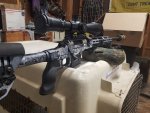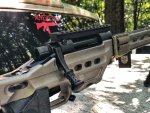Don’t look at it!Um, the bolt knob is kinda ugly?Serious question though, can this be swapped out and if so, what's the thread?
Join the Hide community
Get access to live stream, lessons, the post exchange, and chat with other snipers.
Register
Download Gravity Ballistics
Get help to accurately calculate and scope your sniper rifle using real shooting data.

Install the app
How to install the app on iOS
Follow along with the video below to see how to install our site as a web app on your home screen.
Note: This feature may not be available in some browsers.
You are using an out of date browser. It may not display this or other websites correctly.
You should upgrade or use an alternative browser.
You should upgrade or use an alternative browser.
Nucleus Orders
- Thread starter hereinaz
- Start date
Hey be thankful you have a bolt knob to look at.Don’t look at it!
Any idea on the actual trigger weight range with the diamond?View attachment 6925305
Nucleus action arrived this morning. The action is damn smooth. Doesn't move the rifle off target when operating the bolt like the bolt on the Savage does. Cannot get it to bind no matter what I do.
Bolt stop is difficult to operate in order to remove the bolt. The detent is pretty strong. Seeing reports that it wears in a little.
With the factory Savage barrel nut, I can see one thread on the barrel from this manufacturer. Not a big deal, but I do hope it's not present when I get my Barloc.
Right hand short action, 0.475 bolt face, 20moa rail
KRG Bravo
X-Caliber 26" Savage bull contour 6.5 Creedmoor with Pepper Pot muzzle brake
TriggerTech Diamond
Vortex PST Gen II 5-25x50 EBR-2C MOA
Using a load worked up for a different rifle/barrel:
View attachment 6925306
I'm looking for a 1-2lb range and trying to decide on diamond or special.
Last edited:
and special down to 1lbDiamond goes from 4-32 oz if I recall correctly.
Yep I understand that, but Trigger Tech says it will vary depending on firing pin spring so I was just curious to know if the actual real world weight range was still as advertised or not.
I think he's asking what the actual weight vs advertised since pull weight can vary depending on the spring weight of the action. Ex. Bergara pull is heavier due to springweight.Diamond goes from 4-32 oz if I recall correctly.
I run a diamond and it's set around 8-10oz. I also shoot a Bergara, and it is heavier. I would say your safe with the special if you want a 1.5lb pull
Yes, exactly, I poorly asked it. I want a 1-2lb range. I bought the special, but not yet installed it for my Nucleus but got to thinking that if I want a 1lb bottom and the firing pin spring adds to it, it may not actually have a 1lb bottom and maybe I should take it back and get the diamond. I just don't want the diamond to light on the top end. First world problems I know....lolI think he's asking what the actual weight vs advertised since pull weight can vary depending on the spring weight of the action. Ex. Bergara pull is heavier due to springweight.
I run a diamond and it's set around 8-10oz. I also shoot a Bergara, and it is heavier. I would say your safe with the special if you want a 1.5lb pull
Last edited:
Um, the bolt knob is kinda ugly?Serious question though, can this be swapped out and if so, what's the thread?
Mine has the mausingfield knob.. other than the AI round knob, I don't know of any better knob.
I shot my Nucleus yesterday for the first time, it ran flawless. I had no light strikes. Shot 50 rds of Prime 6.5C, trigger was a new Timney CE 2-stage. This action is smooth...I'm in love.
I put the same trigger in mine. Feels amazing together.
It sure does!
Mine has it too. I honestly think it's the best knob shape out there, perfect for either lifting with one finger or grabbing between your thumb and index finger comfortably since it's got the dip in the center with a little bit of texture for grip that keeps you from slipping at all (side to side or back and forth). I was actually really glad it came with the Mausingfield knob instead of the smoother Nucleus knob that was shown earlier.Mine has the mausingfield knob.. other than the AI round knob, I don't know of any better knob.
I am excited to run my Nucleus at a two day match this weekend. I'll report how it does.View attachment 6928526
Well how did you do this past weekend?
We have these bolt knobs available. Ted is really fond of the middle one. We should be adding these to our website soon.
Cheers

Cheers
Mine had 3 and none fit the Nucleus nut
Hmm. Checked over the weekend. Mine came with two and neither fit the Nucleus. Have you contacted MPA about it?
What's the height on those ARC Rings?
ARC 35mm rings, medium height (28 mm) on a 20 MOA base holding an MK5
Well how did you do this past weekend?
I did OK is all. I finished 63 out of 91 for my first national match. I was chasing dope as my rifle sped up and then I got in my head. On the second day, I said screw it, and then cleaned the next stage, LOL. I ran some good stages after that.
The Nucleus ran flawlessly.
That was going to be my next question. Manners does not inlet for them yet. What are you guys using ?
2 months ago they were not.Has McMillan started inletting stocks for the Nucleus yet? I don't want to use a 700 inlet.
Most stocks being used are inletted for a 700 with no issues.That was going to be my next question. Manners does not inlet for them yet. What are you guys using ?
Pretty sure Manners got their action a week or two ago. I've had a stock on order since February and was told they'd be writing the program and cutting soon.
I am going to take my Nucleus action into McMillian for measuring sometime here in the next couple of weeks.
When I talked with XLR about ordering my chassis for the Nucleus the only difference they had to make with the inlet was that they used a Rem 700 inlet for a straight bolt handle instead of a swept bolt. That said, the chassis doesn't really require bedding in the traditional sense and could be more forgiving to slight changes in the action footprint (though I sure can't tell any difference from mounting a Rem700 action or my Nucleus into the chassis, besides the Rem700 bolt rubbing slightly since it was swept).
When I talked with XLR about ordering my chassis for the Nucleus the only difference they had to make with the inlet was that they used a Rem 700 inlet for a straight bolt handle instead of a swept bolt. That said, the chassis doesn't really require bedding in the traditional sense and could be more forgiving to slight changes in the action footprint (though I sure can't tell any difference from mounting a Rem700 action or my Nucleus into the chassis, besides the Rem700 bolt rubbing slightly since it was swept).
I've got mine in an XLR without any issue at all.
Attachments
20 MOA, says it right on the backWhat size scope base is that??
Do you have to use the nucleus action wrench on the action for shouldered barrels or can you use a different action wrench?
It won't work with a standard Rem 700 action wrench because of the rail. Standard action wrenches don't have long enough bolts to let the wrench go all the way around the action like it's supposed to. I tried it out for grins when screwing on my Criterion pre-fit, so I didn't need it but felt like testing it out anyways.Do you have to use the nucleus action wrench on the action for shouldered barrels or can you use a different action wrench?
You can't really easily install the barrel without the rail attached, because the rail is what ensures the recoil lug is properly in place. If you were willing to deal with lining up the recoil lug properly without the rail to index the lug, you could do it but otherwise you'll need the Nucleus specific wrench.
What way is everyone using to install the savage prefit barrels using the barrel nut instead of the barloc system. Have a new barrel coming in soon and want to make sure I install it correctly.
I ran my Nucleus in the Border War match in Creston, IA last weekend and it performed. I did have an issue on a barricade where my Tactical Udder was pushing on the magazine and I had a hell of a time closing the bolt due to the stresses on the mag. I would have to lift up the rifle to take weight off the mag and then cycle the bolt. Especially if the mag was full. This is in a KRG W-3 Gen 4. But I don't believe it is an action issue but more of a mag/chassis issue. I'll be looking into this more and will update the thread as I gather more info.
Innovation is the mother of invention! I am not running the arca rail, but I do have the aluminum forend. I'll have to look in this. I still want to see if I can adjust the chassis at all first.
I dropped off my Nucleus action at Manners shop a couple weeks back for them to take measurements and test the inlet. They should be ramping up inletting for the Nucleus very soon!That was going to be my next question. Manners does not inlet for them yet. What are you guys using ?
Spoke to them the other day about my FFL and they’re on track.We're getting closer to mid August! Hopefully we start seeing some shipping notifications for that next batch of actions ( including lefties) in the next couple of weeks!
I believe KRG makes an accessory just for this. The barrier stop You can mount it flat side forward or rounded edge forward to be able to move left or right to target without resistance. The barrier multi tool is a larger version and would accomplish more of what you’re looking for I believe. Nice to have both of these for different situations and to be able add it somewhat quickly.Innovation is the mother of invention! I am not running the arca rail, but I do have the aluminum forend. I'll have to look in this. I still want to see if I can adjust the chassis at all first.
https://kineticresearchgroup.com/product/barrier-stop/
https://kineticresearchgroup.com/product/multi-tool/
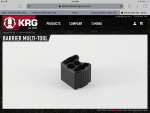
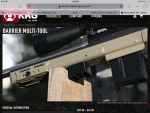
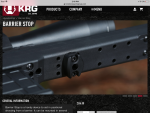
Last edited:
Is anyone getting their actions to consistently control round feed? Mine is consistently push.
Using Magpul or Accurates in XLR Element. Bolt speed does not seem to change outcome.
Same here. Not that I’ve had any feeding issues, per se, but both Magpul and AI mags end up push feed regardless of speed of bolt throw (6.5x47L).
What way is everyone using to install the savage prefit barrels using the barrel nut instead of the barloc system. Have a new barrel coming in soon and want to make sure I install it correctly.
I headspaced mine just using a piece of virgin Lapua brass since the only ammo I'll ever shoot through it is my own handloads (so having it within SAAMI spec isn't critical to me). Get the barrel started into the action, but not very much, and then put a piece of brass in the extractor and close the bolt. Thread the barrel onto the action until I feel the chamber touch up against the brass. Back the barrel off a quarter turn and then slowly tighten it until I just barely feel resistance when I open or close the bolt (chamber just barely touching the brass).
Tighten it all down in a barrel vice, careful not to move it at all (make a sharpie mark and you can tell if the barrel screws in or out any) and double check that the bolt still just has a tiny bit of resistance so the chamber is sized correctly for your brass. Tighten down the barrel nut by hand, then put the action wrench on it and give it a good 2 or 3 wallops with either a mallet or a crescent wrench (whichever is closer). You can torque it to a specific spec if you'd prefer, but I just followed the instructions that came with the Wheeler action wrench of hitting it a few times. Gun still shoots .3" groups with minimal load development so I'd say it worked just fine.
Is anyone getting their actions to consistently control round feed? Mine is consistently push.
Using Magpul or Accurates in XLR Element. Bolt speed does not seem to change outcome.
Feeding out of an AICS w/ spacer kit, Accurate, or Magpul mag I noticed that I'm only really push feeding if I run the bolt slowly. Otherwise it seems to snap over the cartridge rim just fine for me. I can feel when I go slow though that it's snapping the extractor over the cartridge when I close the bolt. I'm running an XLR Envy chassis.
Is anyone getting their actions to consistently control round feed? Mine is consistently push.
Using Magpul or Accurates in XLR Element. Bolt speed does not seem to change outcome.
Now, I don't have my action yet, but I've been seeing this "problem" from a lot of people. My theory is that many magazine types have feed lips that are too long as they are made for push-feed actions.
The benefit of having longer lips for a push feed are pretty obvious: the round has some control on it as long as it possibly can before it needs to get up in front of the bolt face to feed. You don't have rounds jiggling about inside your receiver and getting stuck in places (the offside raceway of Remington 700's come to mind) that they don't need to be.
On the other hand, controlled-round feed actions are made to have complete control of the cartridge early in the feeding cycle while the magazines are still trying to feed like a push-feed. At this point, when the magazine does release the round, it's already ridden the feed ramp and it's getting started toward the chamber. At the head of the cartridge, it's probably getting pushed up by the cartridge below it in the magazine, very close to or past the shoulder of the lower cartridge. When pushed like this, it doesn't receive the full upward "pop" of the magazine spring and gets pushed a little forward due to the sloped shoulder, causing the rim to get out ahead of the extractor and not snapping underneath it. This would be exacerbated with shorter cartridges and steeper shoulders, typical of common modern match cartridges.
If the feed lips were shortened where they would release the cartridge earlier in the feed cycle, then the case would be pushed up under the extractor by the body of the case below it, giving it the most straight vertical push that it can. After that, the bolt face/extractor has control and it should feed straight into the chamber.
Like I've said, I don't have my action yet and I'm definitely not a gunsmith, but it seems to me that a controlled-round feed action would like the magazine to release the round earlier in the feed cycle. If someone doesn't beat me to it, I'll definitely be experimenting with feed lip length when my action comes in (may need to find a bunch of Magpuls cheap). If there are any magazines with shorter feed lips on the market (Alpha's come to mind), they may be worth tinkering with.
Pretty sure the ARC mags have shorter feed lips for this reason
AI mags in mausingfield no problem. Accurates didnt work as well but I'll try them in origin and nucleus before I mess with the lips since they worked fine in a tikka
AI mags in mausingfield no problem. Accurates didnt work as well but I'll try them in origin and nucleus before I mess with the lips since they worked fine in a tikka
As mentioned above, cartridge choice/where the shoulder is in relation to where the feed lips release the round likely play a factor. Most mags are made for .308, if your shoulder is shorter then you may not get that upward push. Don't have my action yet either, just theorizing.
I’d like to see it in action with the ARC mag. It’d be nice to get some feedback from @Jon_ARC on this when they’ve got some free time.Pretty sure the ARC mags have shorter feed lips for this reason
AI mags in mausingfield no problem. Accurates didnt work as well but I'll try them in origin and nucleus before I mess with the lips since they worked fine in a tikka
Now, I don't have my action yet, but I've been seeing this "problem" from a lot of people. My theory is that many magazine types have feed lips that are too long as they are made for push-feed actions.
The benefit of having longer lips for a push feed are pretty obvious: the round has some control on it as long as it possibly can before it needs to get up in front of the bolt face to feed. You don't have rounds jiggling about inside your receiver and getting stuck in places (the offside raceway of Remington 700's come to mind) that they don't need to be.
On the other hand, controlled-round feed actions are made to have complete control of the cartridge early in the feeding cycle while the magazines are still trying to feed like a push-feed. At this point, when the magazine does release the round, it's already ridden the feed ramp and it's getting started toward the chamber. At the head of the cartridge, it's probably getting pushed up by the cartridge below it in the magazine, very close to or past the shoulder of the lower cartridge. When pushed like this, it doesn't receive the full upward "pop" of the magazine spring and gets pushed a little forward due to the sloped shoulder, causing the rim to get out ahead of the extractor and not snapping underneath it. This would be exacerbated with shorter cartridges and steeper shoulders, typical of common modern match cartridges.
If the feed lips were shortened where they would release the cartridge earlier in the feed cycle, then the case would be pushed up under the extractor by the body of the case below it, giving it the most straight vertical push that it can. After that, the bolt face/extractor has control and it should feed straight into the chamber.
Like I've said, I don't have my action yet and I'm definitely not a gunsmith, but it seems to me that a controlled-round feed action would like the magazine to release the round earlier in the feed cycle. If someone doesn't beat me to it, I'll definitely be experimenting with feed lip length when my action comes in (may need to find a bunch of Magpuls cheap). If there are any magazines with shorter feed lips on the market (Alpha's come to mind), they may be worth tinkering with.
I had read about shortening the feed lips before here on SH. For my Mausingfield in 6x47L, being a short OACL, I took some guys advice and took a 10th of an inch off the front of the mag. Feeding was greatly improved because the rim of the case slid under the extractor at the correct timing.
Similar threads
- Replies
- 9
- Views
- 366
- Replies
- 97
- Views
- 3K

